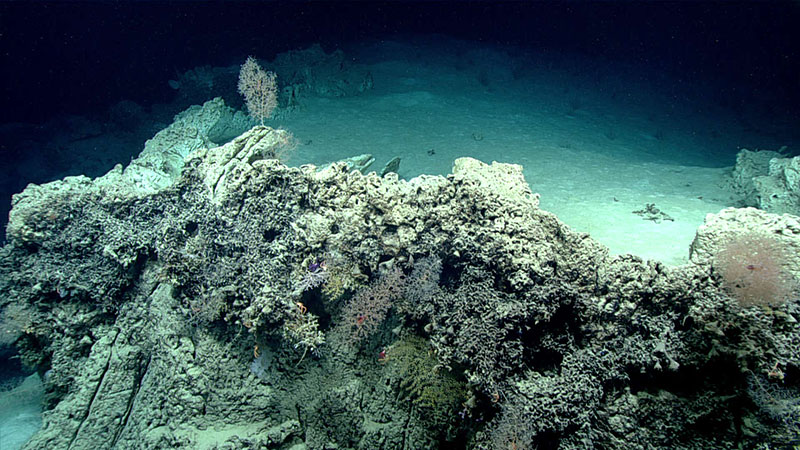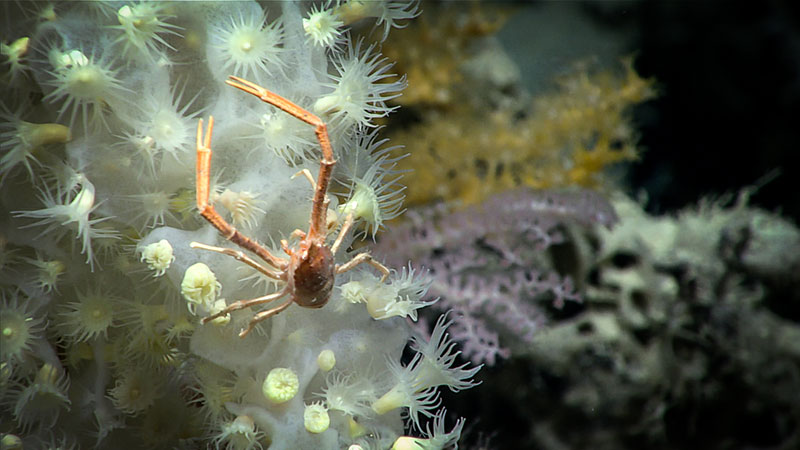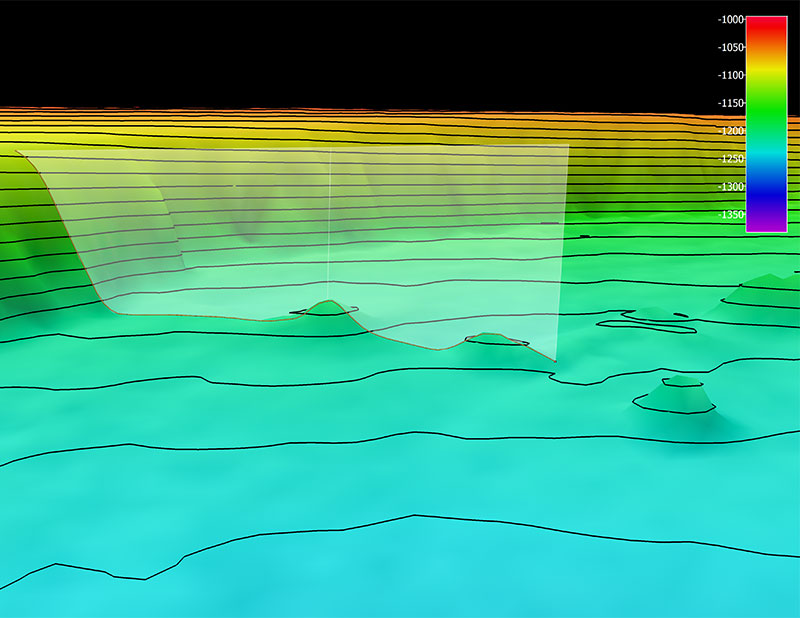
Date: November 18, 2019
Location: Lat: 23.968967°, Long: -81.935617°
Dive Depth Range: 1,132 - 1,218 meters (3,714 - 3,996 feet)
Access Dive Summary and ROV Data

The loose sediments on the top of this boulder, seen on Dive 11 of the 2019 Southeastern U.S. Deep-sea Exploration, are rimmed by an outer layer of more durable encrusted limestone. This suggests that the feature was once taller, but is eroding over time. Image courtesy of the NOAA Office of Ocean Exploration and Research, 2019 Southeastern U.S. Deep-sea Exploration. Download larger version (jpg, 1.4 MB).
Today’s dive took us to a site about 65 kilometers (40 miles) southeast of Key West, Florida, and to the deepest depths of the expedition. This site was originally selected based on mapping data collected during the 2019 NOAA Ship Okeanos Explorer shakedown expedition, but it was refined with data collected just last night. Using this information, we explored two small knob-like features and a neighboring escarpment to learn about the geology of the features and the marine life that calls them home.
We were quite surprised by the geology we encountered on this dive, which featured large limestone boulders, most encrusted, that seemed to have originally come from the nearby escarpment, and were possibly detached during a submarine landslide. It reminded us of how important it is to get up close to deep-sea features like this with our remotely operated vehicles to ground-truth and characterize what we see in the mapping data.
This giant isopod (Bathynomous giganteus) was seen snacking on a fish head during Dive 11 of the 2019 Southeastern U.S. Deep-sea Exploration. These deep-sea scavengers are close relatives of the pill bugs, rolly pollies, and sowbugs found in houses and gardens, but Bathynomus giganteus is much, much larger, growing up to a foot and a half in length. Although giant isopods have been known to exist for more than a century, we still don't know all that much about their biology or behavior, making capturing videos like this one incredibly important (and also really cool). Video courtesy of the NOAA Office of Ocean Exploration and Research, 2019 Southeastern U.S. Deep-sea Exploration. Download larger version (mp4, 74.3 MB).
The escarpment was similar to the boulders. Some of its surfaces were encrusted, while others were exposed with a white chalky texture. These exposed surfaces are likely where pieces were lost to erosion or other events.
On today’s dive, we saw two giant isopods, a sea dandelion, a dumbo octopus, sea stars, a sea lily, red crabs, and a few different soft corals. Stichopathes, a whip-like black coral, was the most common coral seen throughout the dive. While traveling to the escarpment, we saw some midwater animals: jellyfish, squid, and a swimming sea cucumber.
We also continued the expedition's trend of seeing interesting sponges, and today we collected three: two more carnivorous sponges (Chondrocladia), one of which was 60 centimeters (27 inches) tall, and a Geodia, which may be a new species. Not to ignore the geology, we also collected a rock.

We saw both stalked and unstalked crinoids during Dive 11 of the 2019 Southeastern U.S. Deep-sea Exploration. The sea lily shown here is a stalked crinoid. Image courtesy of the NOAA Office of Ocean Exploration and Research, 2019 Southeastern U.S. Deep-sea Exploration. Download larger version (jpg, 878 KB).

Deep-sea swimming sea cucumbers (Pelagothuriidae) are sometimes seen on the seafloor and sometimes in the water column. This one was seen during Dive 11 of the 2019 Southeastern U.S. Deep-sea Exploration. Due to its semitransparent body, we can see its intestine, which is filled with sand from which it extracts its nutrients. Image courtesy of the NOAA Office of Ocean Exploration and Research, 2019 Southeastern U.S. Deep-sea Exploration. Download larger version (jpg, 698 KB).
In addition to our dive and regular ship operations, we also conducted a live interaction today. Stephanie Farrington, Kimberly Galvez, and Shannon Hoy (our science leads and mapping lead, respectively) engaged with a group of University of Rhode Island students at the Inner Space Center, introducing them to the expedition and answering their questions. While not as formal, we also answered questions in the chat room and over the science line from two groups of high school students (from environmental science and physics classes) who were visiting the exploration command center at Harbor Branch Oceanographic Institute at Florida Atlantic University.

This glass sponge (cf. Lefroyella), seen during Dive 11 of the 2019 Southeastern U.S. Deep-sea Exploration, was covered with yellow zoanthids and surrounded by a variety of colorful soft corals. Image courtesy of the NOAA Office of Ocean Exploration and Research, 2019 Southeastern U.S. Deep-sea Exploration. Download larger version (jpg, 901 KB).

This is one of two giant isopods (Bathynomous giganteus) seen during Dive 11 of the 2019 Southeastern U.S. Deep-sea Exploration. Image courtesy of the NOAA Office of Ocean Exploration and Research, 2019 Southeastern U.S. Deep-sea Exploration. Download larger version (jpg, 1.0 MB).

Location of Dive 11 of the 2019 Southeastern U.S. Deep-sea Exploration on November 18, 2019. Download larger version (jpg, 1.8 MB).

The remotely operated vehicle track for Dive 11 of the 2019 Southeastern U.S. Deep-sea Exploration, shown as an orange line with a white curtain. This mapping data was collected during the 2019 NOAA Ship Okeanos Explorer shakedown expedition. Legend shows water depth in meters. Download larger version (jpg, 2.7 MB).